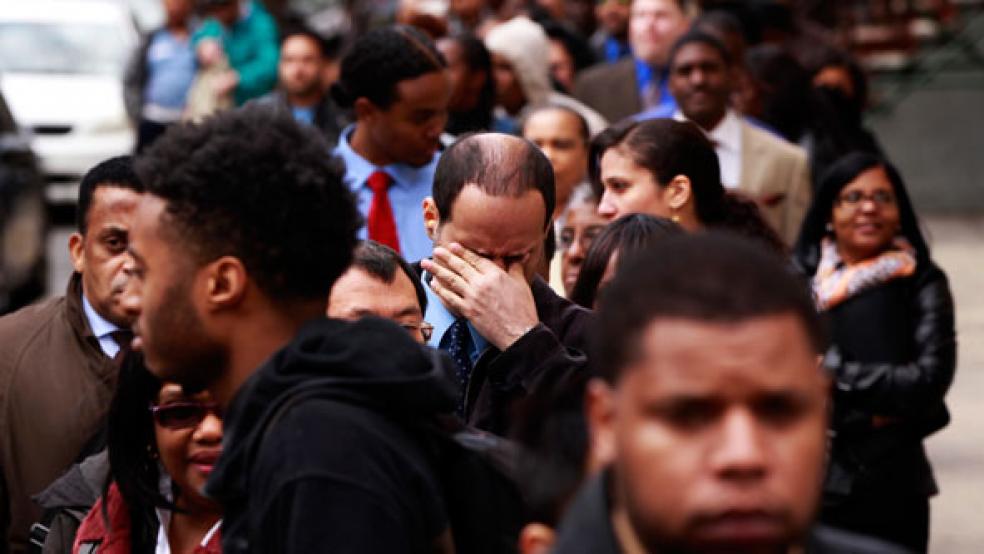The unemployment rate dipped to 8.1 percent in August for the worst possible reason: 368,000 Americans dropped out of the workforce and another 213,000 never even bothered to join it, a reflection of the underlying weakness that President Obama told the Democratic National Convention Thursday night would take several more years to fix.
Republican presidential nominee Mitt Romney glommed onto the discouraging jobs report released Friday morning as evidence of how the economy has stumbled to emerge from the Great Recession under Obama’s leadership.

“If last night was the party, this morning is the hangover,” Romney said in a statement. “For every net new job created, nearly four Americans gave up looking for work entirely.”
The Bureau of Labor Statistics reported the creation of 96,000 net new jobs in August — well below Wall Street expectations of gains of roughly 125,000, which would have been in line with population growth. Many economists had projected a surge in hiring after a private payrolls number issued on Thursday by ADP showed an increase of 201,000.
The meager increase was enough to push down the unemployment rate from 8.3 percent in July only because of the massive exodus from the labor pool. Manufacturers shed 15,000 jobs, half of them in the auto sector celebrated by Obama and Vice President Joe Biden in their convention speeches. Government fired another 7,000 workers. And jobs reports from June and July were revised downward by a combined 41,000.
“Summer’s over, here’s your slap in the face,” read the headline from JPMorgan Chase’s assessment.
In the report’s current population survey, the labor force participation rate dropped to 63.5 percent — its lowest reading since September 1981. When the rate last hit that level — in the middle of a recession — women who once stayed at home were still entering the job market in droves. The participation rate for women peaked around 60 percent in 2009 and now rests at 57.6 percent. For men, the rate is at its worst level in the history of this metric, falling from 86.7 percent in 1948 to 69.8 percent last month.
By estimates from the Romney camp, the unemployment rate would have ticked up to 8.4 percent if labor force participation had stayed constant.
Alan Krueger, chairman of the White House Council of Economic Advisers, did not address the decline in his morning blog post, choosing instead to repeat his monthly call for additional stimulus proposals from Obama that have not garnered support from the Republican majority House of Representatives.
His predecessor, University of Chicago economist Austan Goolsbee, noted the report was in line with the modest growth in gross domestic product, tweeting a simple reassurance: “Folks, chill.”
If there was any upside in the numbers, it was the possibility that the Federal Reserve will approve another round of quantitative easing next week in order to bolster hiring, potentially taking hundreds of billions of dollars of debt out of the market to further lower interest rates.
“The weak job market is also pushing down real earnings,” wrote Kevin Logan, chief U.S. economist at HSBC. “The Fed is looking for ‘substantial and sustainable’ improvement in labor conditions. Today’s report moved in the other direction.”
The prospect of Fed action buoyed the stock market following the letdown, with the Standard & Poor’s 500-stock index up 4 points, or 0.28 percent, in midday trading.
Jim O’Sullivan, chief economist at High Frequency Economics, summarized today’s jobs report as “clearly a disappointment relative to raised expectations after yesterday’s numbers.” He noted, though, that “the net result is still somewhat faster employment growth so far in Q3 – 119k per month – than the 67K per month in Q2.”
If there’s one faint glimmer of hope for the president, it might be that the new report presents the possibility that the unemployment rate could fall below the 8 percent threshold by Election Day — a positive development for Obama, unless you consider the economic pain and workforce departures that made it possible.
“I’m sure the president would rather not get there this way, but it does prompt the question: How many people need to drop out of the labor force for the unemployment rate to dip below 8 percent by Election Day?” wrote Tony Fratto, a former Treasury official in George W. Bush’s administration and now the managing partner of Hamilton Place Strategies.
“It’s certainly possible that the supply of labor falls enough that the unemployment rate actually gets below 8 percent before the election, but it would be like sneaking into the party through the out door.”


